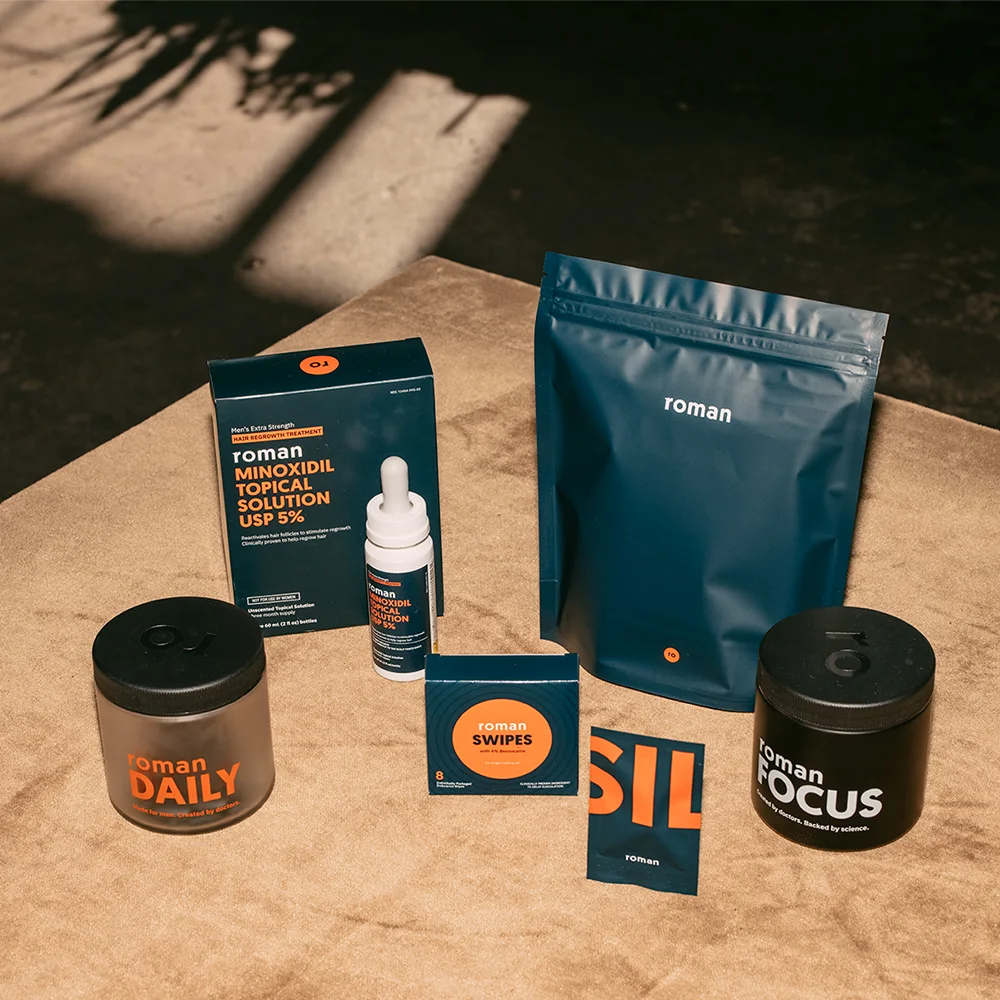Here's what we'll cover
Here's what we'll cover
Pain is never fun. But testicular pain can cause a special kind of agony.
Apart from being debilitating, testicular pain—though common—is also associated with several medical conditions. But don’t freak out. There are plenty of non-serious explanations for your issues “down there.” In many cases, only a healthcare professional can identify the cause of your pain and offer the appropriate medical treatment.
What is testicular pain?
Experts tend to break down testicular pain into two categories: “acute” and “chronic” (Velasquez, 2021):
Acute testicular pain
In medical terminology, “acute” refers to pain that is new and typically sharp or intense. Acute testicular pain refers to any kind of pain you feel inside your scrotum (Velasquez, 2021). This pain can take a lot of different forms, each of which may point to a different underlying cause. These include (Gordhan, 2015):
Severe pain
Unilateral (one side only) or bilateral (both sides) pain
Dull pain that gradually gets worse
Aching or throbbing pain
Pain that gets worse when you’re standing
Pain accompanied by swelling, fever, or stinging urine
Pain that spreads or encompasses other parts of your body
The pain may come on and peak quickly—sometimes in a matter of minutes. Or it may build for days (Velasquez, 2021).
Chronic testicular pain
“Chronic” refers to pain that keeps coming back, again and again. Some medical conditions can lead to chronic pain of the testicles. (More on those below.) But, when the pain first appears, the symptoms of chronic pain are pretty much the same as those of acute pain (Velasquez, 2021).
In other words, you can’t tell by your early symptoms whether you’re dealing with a chronic issue or something that causes short-term testicular pain.
Common causes of testicular pain
A lot of things can make your testicles hurt, including things you may have done a thousand times before without any problem. Exercise, weightlifting, and other forms of physical exertion (like lifting heavy boxes or furniture) can cause or worsen pain in your testicles. Of course, so can trauma, like getting hit or kicked in the area (Velasquez, 2021).
Even if you think you know why your testicles hurt, it may be worth seeing a healthcare professional if the pain doesn’t go away within an hour, especially if it keeps getting worse. Injuring your testicles can sometimes trigger or reveal serious complications that need immediate medical attention (Cleveland Clinic, 2016; Zhong, 2021).
Along with strain, trauma, or other short-term pain triggers, a long list of medical conditions can lead to testicular pain. Some of the most common include:
Testicular torsion
Torsion means twisting. Testicular torsion refers to several closely related medical conditions. In each of them, either the testicles or other scrotal contents twist in a way they shouldn’t. This twisting can cut blood flow to the testicles, which is dangerous and painful (Gordhan, 2015).
In most cases of torsion, the pain is mainly on one side of the scrotum—not both. The pain can be intense and may get worse as time passes. In some cases, it can cause nausea and vomiting.
Some people experience torsion pain that resolves temporarily but then comes back again. Eventually, the pain will not resolve by itself, and the testicle will be in danger (Gordhan, 2015).
Torsion is common, especially among young men. About one in every 160 men will experience torsion before they turn 25. It’s less common—but still happens—later in adulthood (Velasquez, 2021; Cummings, 2002).
Torsion is an urgent medical problem. If not treated promptly—often with surgery—it can lead to losing one or both testicles. If you’re treated by a healthcare professional within six hours from when your symptoms start, the “salvage rate” for your testicles is greater than 90%. But that drops with each hour that passes. By the 24-hour mark, the risk of losing a testicle rises above 90% (Howe, 2017).
Epididymitis
Epididymitis is an infection of the epididymis, a coiled tube that sits behind the testicles and transports sperm. Microorganisms that have spread from the urethra or another nearby infection site often cause this condition. It causes swelling and inflammation of the epididymis, which can feel like pain in the testicles (Gordhan, 2015).
Epididymitis is the most common cause of acute scrotal pain in adult men. It often stems from chlamydia or gonorrhea, which are sexually transmitted infections, although urinary tract infections can also cause it (Gordhan, 2015). Over 600,000 men are diagnosed with epididymitis in the U.S. each year (Trojian, 2009).
Epididymitis pain usually starts as a dull ache that gradually increases, although that’s not always the case. The pain is generally on one side of your scrotum. Antibiotics are the usual treatment for epididymitis in both adults and kids (McConaghy, 2016).
Varicoceles
Veins that dilate (enlarge) and inflame inside the scrotum are varicoceles. These enlarged veins can cause pain in ways healthcare professionals don’t quite understand. There’s some speculation that they push against the testicles or other contents of the scrotum in ways that hurt. They may also raise the temperature of the testicles, which can be painful (Paick, 2019).
About 15% of all men are estimated to have varicoceles, although they’re not painful for most (90% or more). If pain does occur, it is usually a dull, aching, or throbbing pain in the testicle, scrotum, or groin. It’s not typically sharp or stabbing, although it can be. People with varicoceles often feel a “heaviness” in their scrotum that worsens with exercise, physical activity, or after standing (Paick, 2019).
Trained healthcare professionals describe varicoceles as feeling like a “bag of worms” inside the scrotum (Gordhan, 2015). Varicoceles are a common cause of infertility, although this is often reversible. Treatment begins with rest and anti-inflammatory drugs. If those don’t help, surgical repair or removal of the enlarged veins may be necessary (Paick, 2019).
Cysts or lumps
A handful of different medical conditions can cause a lump to form on or around your testicles. In most cases, these lumps aren’t cancer. One study found that out of 845 people with testicular lumps or pain, only 4% turned out to have testicular cancer (Stonier, 2017).
The most common causes of testicular lumps and pain are (Stonier, 2017; Rioja, 2011):
Epididymal cysts: fluid-filled lumps that usually form around the epididymis.
Hydrocele: a mass of fluid that collects in the lining around the testicle.
For both spermatoceles and hydroceles, pain is uncommon, but if there’s pain, it can be intense. Experts aren’t sure why these lumps form, although some kind of injury or fluid backup may be to blame. They often don’t need treatment beyond painkillers, although drainage or surgery may be necessary (Rioja, 2011).
Testicular cancer can also cause a lump or pain (or both) in your testicles. This form of cancer is rare; roughly 9,000 men are diagnosed with testicular cancer each year. One of every 250 men will develop testicular cancer at some point during their lifetime. It’s most commonly diagnosed among men in their early 30s, although it can appear earlier or later (Baird, 2018; ACS, 2021).
The main symptoms of testicular cancer are hard to differentiate from other causes. They include (Baird, 2018):
Sharp or dull pain in the testicles
Firmness of the testicles
Scrotal heaviness or swelling
A testicular tumor (lump or solid mass) on one or both testicles, which may be painless
Inflammation of the testicles (orchitis)
Testicular cancer can also cause GI symptoms, headaches, low back pain, and other symptoms that have nothing to do with your genitals. Usually, a medical professional will use an ultrasound—among other tests—to determine if cancer is causing your symptoms.
The good news: Almost all men who undergo treatment for testicular cancer survive. The most common treatment is the removal of the testicles (Baird, 2018).
Causes of chronic testicular pain
One cause of chronic (recurrent) testicular pain is a vasectomy. That’s the surgery men have if they no longer want to have kids. About 15% of men experience chronic pain after vasectomy, although only about half seek treatment. This pain most often starts two years after vasectomy, although it can appear earlier or later (Gordhan, 2015).
Experts aren’t sure exactly why some men experience this pain. Treatment usually starts with pain relievers, rest, hot or cold compresses, or inflammation-blocking drugs such as ibuprofen. In some cases, follow-up surgery may be helpful (Sinha, 2017).
Another form of chronic testicular pain is called orchialgia—a regular or constant testicular pain that lasts more than three months. Experts aren’t sure what brings it on; they sometimes link it to trauma, vasectomy, torsion, and nerve damage. But in some men, there’s no apparent trigger.
Orchialgia is diagnosed based on exclusion. That means a healthcare professional (typically, a urologist) will only diagnose it after eliminating all possible causes. Treatment can include painkillers, anti-inflammatory drugs, antibiotics, nerve blockers, or a handful of other measures (Leslie, 2021).
Other causes of testicular pain
The medical conditions mentioned are some of the most common causes of testicular pain. But there are others (Gordhan, 2015).
Sensory fibers in the scrotum and testicles connect to the spinal cord and surrounding regions. As a result, back pain, infections, or other seemingly unrelated problems can, in some cases, cause pain in the testicles. For example, an inguinal hernia, kidney stone, or infection of the abdomen (peritonitis) can all cause testicle pain (Gordhan, 2015).
Again, you probably need to see a medical professional to figure out what’s causing your issues.
When to see a doctor
Some of the most common causes of testicular pain, such as torsion, are serious medical emergencies. You may want to take a “better safe than sorry” approach. That means seeing a healthcare professional asap (Gordhan, 2015).
Especially if your pain didn’t follow an obvious trigger—like a bump or injury—and if it doesn’t get better within an hour, you should get to a clinic or other medical office immediately (Cleveland Clinic, 2016). Ditto if you have pain that resolves but then comes back again, which can be a sign of torsion (Gordhan, 2015).
Most causes of testicular pain are highly treatable. There’s no reason to stress. But you also shouldn’t ignore pain “down there,” especially if it keeps coming back or becomes worse.
DISCLAIMER
If you have any medical questions or concerns, please talk to your healthcare provider. The articles on Health Guide are underpinned by peer-reviewed research and information drawn from medical societies and governmental agencies. However, they are not a substitute for professional medical advice, diagnosis, or treatment.
American Cancer Society (ACS). (2021). Key statistics for testicular cancer . Retrieved September 30, 2021 from https://www.cancer.org/cancer/testicular-cancer/about/key-statistics.html
Baird, D. C., Meyers, G. J., & Hu, J. S. (2018). Testicular Cancer: Diagnosis and Treatment. American family physician , 97 (4), 261–268. Retrieved from https://www.aafp.org/pubs/afp/issues/2018/0215/p261.html
Cleveland Clinic. (2016). Testicular Pain. Retrieved September 22, 2021, from https://my.clevelandclinic.org/health/symptoms/16292-testicular-pain
Cummings, J. M., Boullier, J. A., Sekhon, D., & Bose, K. (2002). Adult testicular torsion. The Journal of Urology , 167 (5), 2109–2110. Retrieved from https://pubmed.ncbi.nlm.nih.gov/11956451/
Gordhan, C. G., & Sadeghi-Nejad, H. (2015). Scrotal pain: evaluation and management. Korean Journal of Urology , 56 (1), 3–11. doi: 10.4111/kju.2015.56.1.3. Retrieved from https://pubmed.ncbi.nlm.nih.gov/25598931/
Howe, A. S., Vasudevan, V., Kongnyuy, M., Rychik, K., Thomas, L. A., Matuskova, M., et al. (2017). Degree of twisting and duration of symptoms are prognostic factors of testis salvage during episodes of testicular torsion. Translational Andrology and Urology , 6 (6), 1159–1166. doi: 10.21037/tau.2017.09.10. Retrieved from https://www.ncbi.nlm.nih.gov/pmc/articles/PMC5760391/
Leslie, S. W., Sajjad, H., & Siref, L. (2021). Chronic testicular pain and orchalgia. [Updated Aug 12, 2021]. In: StatPearls [Internet]. Retrieved from https://www.ncbi.nlm.nih.gov/books/NBK482481/
McConaghy, J. R., & Panchal, B. (2016). Epididymitis: an overview. American Family Physician, 94 (9), 723-726. Retrieved from https://pubmed.ncbi.nlm.nih.gov/27929243/
Paick, S., & Choi, W. S. (2019). Varicocele and Testicular Pain: A Review. The World Journal of Men's Health , 37 (1), 4–11. doi: 10.5534/wjmh.170010. Retrieved from https://www.ncbi.nlm.nih.gov/pmc/articles/PMC6305863/
Rioja, J., Sánchez-Margallo, F. M., Usón, J., & Rioja, L. A. (2011). Adult hydrocele and spermatocele. BJU International , 107 (11), 1852–1864. doi: 10.1111/j.1464-410X.2011.10353.x. Retrieved from https://pubmed.ncbi.nlm.nih.gov/21592287/
Sinha, V., & Ramasamy, R. (2017). Post-vasectomy pain syndrome: diagnosis, management and treatment options. Translational Andrology and Urology, 6 (1), S44-S47. doi: 10.21037/tau.2017.05.33. Retrieved from https://www.ncbi.nlm.nih.gov/pmc/articles/PMC5503923/
Stonier, T., Simson, N., & Challacombe, B. (2017). Diagnosing testicular lumps in primary care. The Practitioner , 261 (1803), 13–17. Retrieved from https://pubmed.ncbi.nlm.nih.gov/29020728/
Trojian, T. H., Lishnak, T. S., & Heiman, D. (2009). Epididymitis and orchitis: an overview. American Family Physician , 79 (7), 583–587. Retrieved from https://www.aafp.org/pubs/afp/issues/2009/0401/p583.html
Velasquez, J., Boniface, M. P., & Mohseni, M. (2021). Acute Scrotum Pain. [Updated July 18, 2021]. In: StatPearls [Internet]. Retrieved from https://www.ncbi.nlm.nih.gov/books/NBK470335/?report=classic
Zhong, H., & Bi, Y. (2021). Pediatric Trauma-Induced Testicular Torsion: A Surgical Emergency. Urologia Internationalis , 105 (3-4), 221–224. doi: 10.1159/000511747. Retrieved from https://pubmed.ncbi.nlm.nih.gov/33378756/










